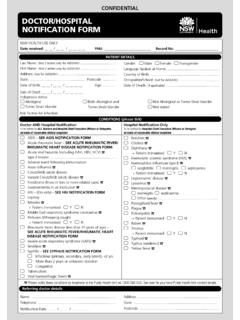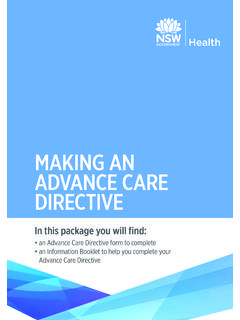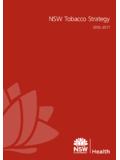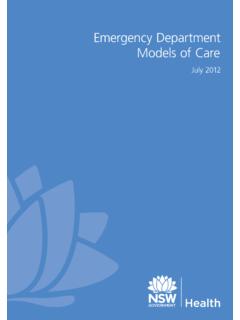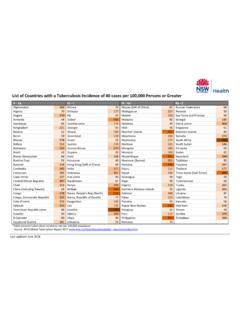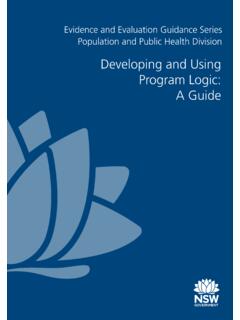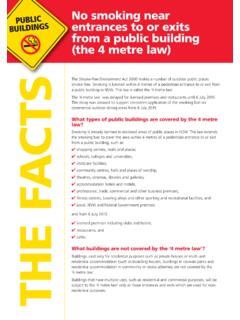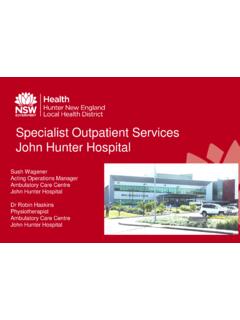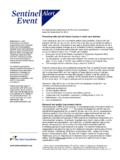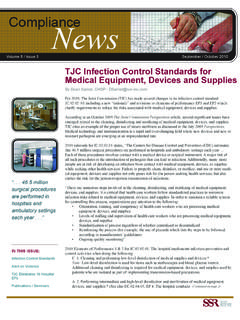Transcription of Safety Advocate 4 - NSW Health
1 Safety AdvocateSafety Advocateinforms aboutincidents or sentinel events thathave been reported to public andprivate Health care organisations in NSW, Australia and overseas. It describes the commonunderlying causes of the events,suggests steps to preventoccurrences in the future andprovides information sources toassist organisations in reviewingand updating their own NSW Health Department NewsletterIssue 4, April 2003 Bed rail safetyBetween 1995 and 2001 in the United States, the US Food and DrugAdministration received 237 reports of death associated with bed rail entrapmentand numerous injuries and near misses associated with collapsing bed the number of reported incidents is small relative to the large numberof patients and nursing home residents who use hospital beds, appropriateprecautions can reduce further that may lead to entrapmentAll reported entrapments occurred in one of the following ways: Through the bars of an individual side rail.
2 Through the space between split side rails. Between the side rail and mattress. Between the headboard or footboard, side rail and deaths involved entrapment of the head, neck, or upper body while mostinjuries involved fractures, cuts and abrasions to the at high risk of entrapment include those with pre-existing conditionssuch as confusion, restlessness, lack of muscle control, or a combination of thesefactors. Increased risk also occurs when the patient s size and/or weight areinappropriate for the bed s dimensions. Air mattresses can pose an increased riskas mattress compression can widen the space between the mattress and the rail,or create a ramp that allows the patient to roll off the bed or against the bed , this risk should be managed, rather than abandoning the use of airmattresses to prevent or treat pressure who have problems with memory, sleeping, incontinence, pain,uncontrolled body movement, or who get out of bed and walk unsafely withoutassistance, must be carefully assessed for the best ways to keep them from harm,(such as falling).
3 Assessment by the patient s Health care team will help todetermine how best to keep the patient benefits of bed rails include: aiding in turning and repositioning within the bed providing a hand-hold for getting into or out of bed providing a feeling of comfort and security reducing the risk of patients falling out of bed when being transported providing easy access to bed controls and personal care risks of bed rails may include: strangling, suffocating, bodily injury or death when patients or part of theirbody are caught between rails or between the bed rails and mattress more serious injuries from falls when patients climb over rails feeling isolated or unnecessarily restricted preventing patients who are able to get out of bed from performing routine activities such as going to the bathroom or retrieving somethingfrom a further information pleasecontact Su Reid, Quality andClinical Policy Branch on Tel.
4 (02) 9391 9271 or by email is expected that Health careorganisations will becomefamiliar with and use theinformation from the SafetyAdvocateto:PlanPlan the changes by reviewing and considering the information, if appropriateto the organisation s the planned changeswhen designing or redesigningrelevant these systems in light of information in the SafetyAdvocateand the results of the Act on relevant suggestions or reasonable alternatives or provide a reasonableexplanation for taking no to reduce entrapment incidentsTo help prevent entrapment deaths associated with bed rails, the US JointCommission on Accreditation of Healthcare Organisations (JCAHO) recommendsthat Health care organisations take the following precautions:1.
5 Provide orientation and training to staff about entrapment dangers with bed railsand assessment of patients for entrapment risk, as appropriate to the patientpopulation and the care Assess patients for risk of entrapment, including physical, mental, behavioral ormedication Re-evaluate beds for entrapment potential, including gap measurement andappropriate sizing of mattresses for bed For individual patients at risk for entrapment, implement appropriate changes to beds (for example, the use of retrofit kits, bed rail netting, clear padding,Velcro or anti-skid mats) to reduce the risk of When possible, keep patients with risk factors for entrapment under morefrequent patients can be in bed safely without bed rails.
6 Consider the following: Use beds that can be raised and lowered close to the floor to accommodate both patient and Health care worker needs. Keep the bed in the lowest position with wheels locked. Use transfer or mobility aids. Monitor patients frequently. Anticipate the reasons patients get out of bed, such as hunger, thirst, going to thebathroom, restlessness and pain and meet these needs ahead of time by offeringfood and fluids, scheduling ample toileting, and providing calming interventionsand pain relief. Inspect all hospital bed frames, bed side rails and mattresses as part of a regularmaintenance program to identify areas of possible entrapment.
7 Regardless of mattress width, length and/or depth, the alignment of the bedframe, bed side rail and mattress should not leave a gap wide enough to entrap a patient s head or body. Beware that movement or compression of the mattress can create gaps. Be alert to replacement mattresses and bed rails with dimensions that differ fromthe original equipment supplied or specified by the bed frame bed rails are used, perform an on-going assessment of the patient s physical and mental status, and closely monitor high-risk patients. Also, consider the following: Lower one or more sections of the bed rail, such as the foot rail.
8 Use a proper size mattress or mattress with raised foam edges to prevent patientsfrom being trapped between the mattress and rail. Reduce the gaps between the mattress and side rails. Take care not to crush tubes and electrical cords when adjusting bed rails and avoid injuries such as amputation of finger tips due to collapsing informationA guide to bed rail safetyUS Food and Drug Administration, Event AlertIssue 27 September 6 2002, Bed rail-related entrapment deaths +us/news+letters/ sentinel +event+ Commission on Accreditation of Healthcare Organisations Collapse of Medicraft electric bed side rails , NSW Department of Health Circular2002/83 April 2003 SHPN: (QCP) 030011 ISSN.
9 1446-9502 Please distribute thispublication to the appropriatepeople within your publication is available on the NSW HealthNet site: NSW Department of Health 2003 This work may only be reproduced in whole for study and training purposes subject to the inclusion of an acknowledgement of the usage or sale is not permitted.
